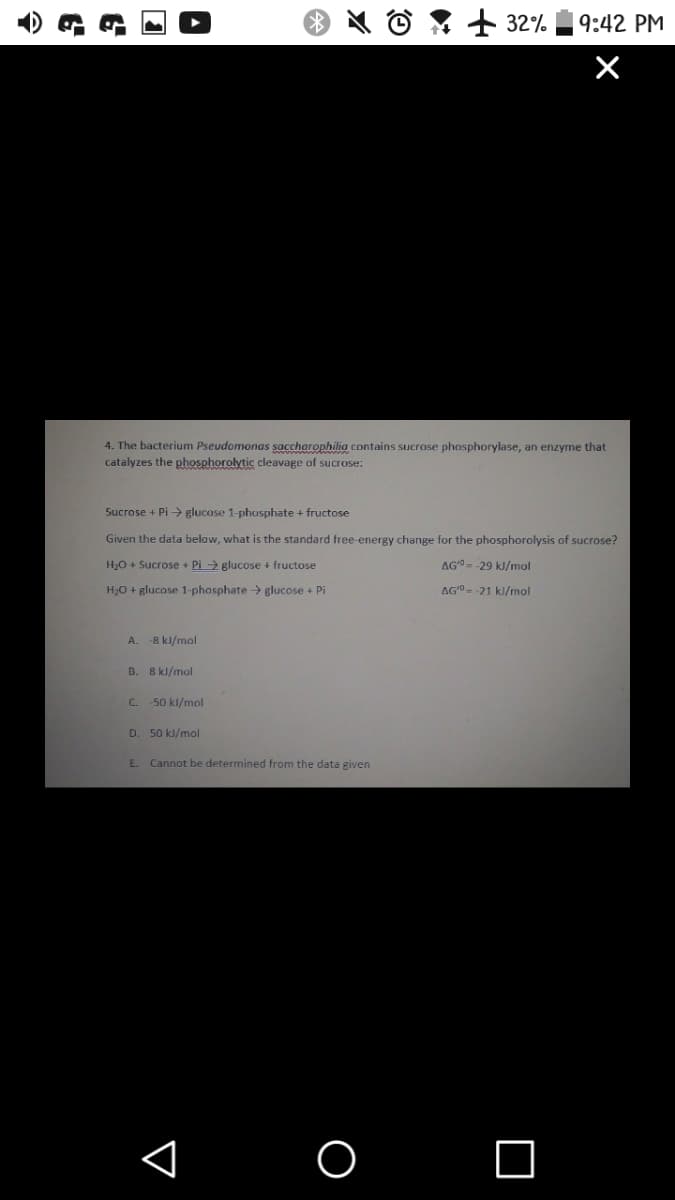4. The bacterium Pseudomonas saccharophilia contains sucrose phosphorylase, an enzyme that catalyzes the phosphorolytic cleavage of sucrose: Sucrose + Pi > glucose 1-phosphate + fructose Given the data below, what is the standard free-energy change for the phosphorolysis of sucrose? H20 + Sucrose + Pi glucose + fructose AG- -29 kJ/mol H;0 + glucose 1-phosphate > glucose + Pi AG- -21 kl/mol A. -8 kl/mol B. 8 kJ/mol C. 50 kl/mol D. 50 kl/mol E. Cannot be determined from the data given
4. The bacterium Pseudomonas saccharophilia contains sucrose phosphorylase, an enzyme that catalyzes the phosphorolytic cleavage of sucrose: Sucrose + Pi > glucose 1-phosphate + fructose Given the data below, what is the standard free-energy change for the phosphorolysis of sucrose? H20 + Sucrose + Pi glucose + fructose AG- -29 kJ/mol H;0 + glucose 1-phosphate > glucose + Pi AG- -21 kl/mol A. -8 kl/mol B. 8 kJ/mol C. 50 kl/mol D. 50 kl/mol E. Cannot be determined from the data given
Organic Chemistry
8th Edition
ISBN:9781305580350
Author:William H. Brown, Brent L. Iverson, Eric Anslyn, Christopher S. Foote
Publisher:William H. Brown, Brent L. Iverson, Eric Anslyn, Christopher S. Foote
Chapter5: Alkenes: Bonding, Nomenclature, And Properties
Section: Chapter Questions
Problem 5.31P
Related questions
Question
Can you use black ink pen and plane paper

Transcribed Image Text:+ 32%
9:42 PM
4. The bacterium Pseudomonas saccharophilia contains sucrose phosphorylase, an enzyme that
catalyzes the phosphorolytic cleavage of sucrose:
Sucrose + Pi > glucose 1-phosphate + fructose
Given the data below, what is the standard free-energy change for the phosphorolysis of sucrose?
H2O + Sucrose + Pi → glucose + fructose
AG- -29 kl/mol
H20 + glucose 1-phosphate > glucose + Pi
AGO- 21 kl/mol
A.
-8 kl/mol
B. 8 kJ/mol
C.
50 kl/mol
D. 50 kl/mol
E.
Cannot be determined from the data given
Expert Solution
This question has been solved!
Explore an expertly crafted, step-by-step solution for a thorough understanding of key concepts.
This is a popular solution!
Trending now
This is a popular solution!
Step by step
Solved in 2 steps with 2 images

Knowledge Booster
Learn more about
Need a deep-dive on the concept behind this application? Look no further. Learn more about this topic, chemistry and related others by exploring similar questions and additional content below.Recommended textbooks for you

Organic Chemistry
Chemistry
ISBN:
9781305580350
Author:
William H. Brown, Brent L. Iverson, Eric Anslyn, Christopher S. Foote
Publisher:
Cengage Learning

Chemistry: Principles and Reactions
Chemistry
ISBN:
9781305079373
Author:
William L. Masterton, Cecile N. Hurley
Publisher:
Cengage Learning


Organic Chemistry
Chemistry
ISBN:
9781305580350
Author:
William H. Brown, Brent L. Iverson, Eric Anslyn, Christopher S. Foote
Publisher:
Cengage Learning

Chemistry: Principles and Reactions
Chemistry
ISBN:
9781305079373
Author:
William L. Masterton, Cecile N. Hurley
Publisher:
Cengage Learning
